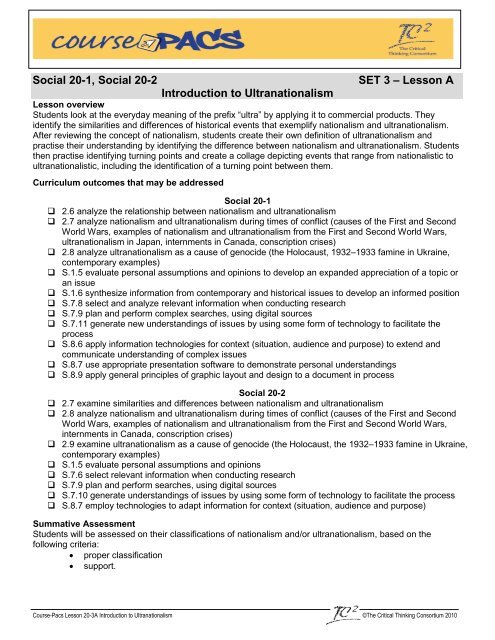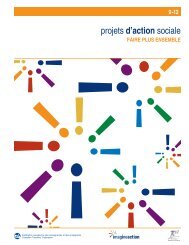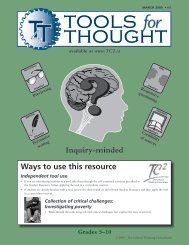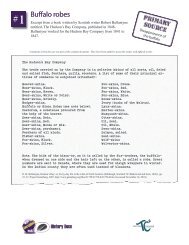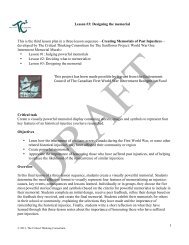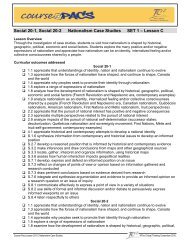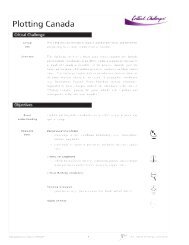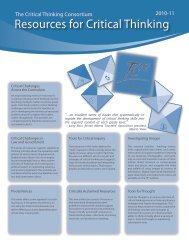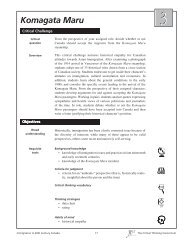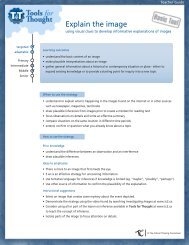Lesson A Introduction to Ultranationalism - The Critical Thinking ...
Lesson A Introduction to Ultranationalism - The Critical Thinking ...
Lesson A Introduction to Ultranationalism - The Critical Thinking ...
Create successful ePaper yourself
Turn your PDF publications into a flip-book with our unique Google optimized e-Paper software.
1<br />
Social 20-1, Social 20-2<br />
<strong>Introduction</strong> <strong>to</strong> <strong>Ultranationalism</strong><br />
SET 3 – <strong>Lesson</strong> A<br />
<strong>Lesson</strong> overview<br />
Students look at the everyday meaning of the prefix ―ultra‖ by applying it <strong>to</strong> commercial products. <strong>The</strong>y<br />
identify the similarities and differences of his<strong>to</strong>rical events that exemplify nationalism and ultranationalism.<br />
After reviewing the concept of nationalism, students create their own definition of ultranationalism and<br />
practise their understanding by identifying the difference between nationalism and ultranationalism. Students<br />
then practise identifying turning points and create a collage depicting events that range from nationalistic <strong>to</strong><br />
ultranationalistic, including the identification of a turning point between them.<br />
Curriculum outcomes that may be addressed<br />
Social 20-1<br />
2.6 analyze the relationship between nationalism and ultranationalism<br />
2.7 analyze nationalism and ultranationalism during times of conflict (causes of the First and Second<br />
World Wars, examples of nationalism and ultranationalism from the First and Second World Wars,<br />
ultranationalism in Japan, internments in Canada, conscription crises)<br />
2.8 analyze ultranationalism as a cause of genocide (the Holocaust, 1932–1933 famine in Ukraine,<br />
contemporary examples)<br />
S.1.5 evaluate personal assumptions and opinions <strong>to</strong> develop an expanded appreciation of a <strong>to</strong>pic or<br />
an issue<br />
S.1.6 synthesize information from contemporary and his<strong>to</strong>rical issues <strong>to</strong> develop an informed position<br />
S.7.8 select and analyze relevant information when conducting research<br />
S.7.9 plan and perform complex searches, using digital sources<br />
S.7.11 generate new understandings of issues by using some form of technology <strong>to</strong> facilitate the<br />
process<br />
S.8.6 apply information technologies for context (situation, audience and purpose) <strong>to</strong> extend and<br />
communicate understanding of complex issues<br />
S.8.7 use appropriate presentation software <strong>to</strong> demonstrate personal understandings<br />
S.8.9 apply general principles of graphic layout and design <strong>to</strong> a document in process<br />
Social 20-2<br />
2.7 examine similarities and differences between nationalism and ultranationalism<br />
2.8 analyze nationalism and ultranationalism during times of conflict (causes of the First and Second<br />
World Wars, examples of nationalism and ultranationalism from the First and Second World Wars,<br />
internments in Canada, conscription crises)<br />
2.9 examine ultranationalism as a cause of genocide (the Holocaust, the 1932–1933 famine in Ukraine,<br />
contemporary examples)<br />
S.1.5 evaluate personal assumptions and opinions<br />
S.7.6 select relevant information when conducting research<br />
S.7.9 plan and perform searches, using digital sources<br />
S.7.10 generate understandings of issues by using some form of technology <strong>to</strong> facilitate the process<br />
S.8.7 employ technologies <strong>to</strong> adapt information for context (situation, audience and purpose)<br />
Summative Assessment<br />
Students will be assessed on their classifications of nationalism and/or ultranationalism, based on the<br />
following criteria:<br />
proper classification<br />
support.<br />
Course-Pacs <strong>Lesson</strong> 20-3A <strong>Introduction</strong> <strong>to</strong> <strong>Ultranationalism</strong> ©<strong>The</strong> <strong>Critical</strong> <strong>Thinking</strong> Consortium 2010
2<br />
Students will be assessed on their collages, based on the following criteria:<br />
visuals represent increasing intensity<br />
turning point<br />
explana<strong>to</strong>ry paragraph and/or presentation<br />
visual appeal.<br />
LESSON ACTIVITIES<br />
Teacher preparation<br />
1) Print a class set of student booklets (20-SB3A).<br />
2) Make 20-WL3A digitally available for students <strong>to</strong> access (if necessary).<br />
Legend of symbols<br />
ideas for differentiated instruction<br />
assessment (―for‖ or ―of‖ learning)<br />
EXPLORING ULTRA<br />
Select the superior product<br />
Click on Internet links <strong>to</strong> reveal pictures of three different products—<br />
Clearasil, an ultrathin cell phone and (optional) Michelob beer—in their<br />
regular and ―ultra‖ forms, and ask students <strong>to</strong> vote for the product they<br />
would rather buy.<br />
Justify your choice<br />
Invite students <strong>to</strong> discuss the specific fac<strong>to</strong>rs that make one product better<br />
than another, and invite them <strong>to</strong> write a statement that summarizes their<br />
idea of the prefix ―ultra‖ so far.<br />
COMPARING HISTORICAL EVENTS<br />
Identify similarities and differences<br />
Students choose two events from <strong>to</strong>pic A and two from <strong>to</strong>pic B. As they<br />
explore the events, help students find the fac<strong>to</strong>rs that the two events from<br />
<strong>to</strong>pic A have in common and the fac<strong>to</strong>rs that the two events from <strong>to</strong>pic B<br />
have in common. <strong>The</strong>n challenge students <strong>to</strong> create a list containing the<br />
biggest differences between <strong>to</strong>pics A and B. By the time students complete<br />
this task, they should recognize that the A <strong>to</strong>pics represent nationalism and<br />
the B <strong>to</strong>pics represent ultranationalism.<br />
Define terms and provide examples<br />
Give students an explanation of nationalism <strong>to</strong> copy in<strong>to</strong> their student<br />
booklets, and invite them <strong>to</strong> think of examples with a partner. Next,<br />
students create their own explanations and provide three examples of the<br />
concept of ultranationalism, using the knowledge they have gained so far in<br />
this lesson.<br />
Practise your understanding<br />
Guide students through three linked pages of his<strong>to</strong>rical events (the space<br />
race, World Cup soccer and Japanese internment). After giving students<br />
the information on each page, invite them <strong>to</strong> determine whether the events<br />
are examples of nationalism, ultranationalism or both, explaining their<br />
reasoning using specific detail from the sources provided.<br />
Use the rubric provided <strong>to</strong> assess the classifications. Look for proper<br />
classifications and support in students’ explanations.<br />
SB Page 1 Students circle<br />
their choice of product then<br />
write the <strong>to</strong>tal class votes in<br />
the boxes provided.<br />
Students brains<strong>to</strong>rm ideas,<br />
using the chart provided.<br />
SB Page 2 Students<br />
complete a similarities and<br />
differences chart.<br />
SB Page 2 Students copy<br />
an explanation and create<br />
examples of nationalism.<br />
Students write their own<br />
explanations and examples<br />
of ultranationalism.<br />
SB Page 3 Students check<br />
the box beside their choice<br />
and write their reasons for<br />
each event.<br />
Course-Pacs <strong>Lesson</strong> 20-3A <strong>Introduction</strong> <strong>to</strong> <strong>Ultranationalism</strong> ©<strong>The</strong> <strong>Critical</strong> <strong>Thinking</strong> Consortium 2010
JUDGING THE TURNING POINT<br />
Practise identifying turning points<br />
Help students determine the point at which one thing evolves in<strong>to</strong> another<br />
by using two examples: the life cycle of a frog and Joe’s ―I am Canadian‖<br />
rant. Invite students <strong>to</strong> explain their opinions of the point at which a tadpole<br />
becomes a frog, and the point at which Joe becomes ultrapassionate about<br />
being Canadian.<br />
Identify criteria for a turning point<br />
Take students through the criteria of a turning point, as it pertains <strong>to</strong><br />
nationalism becoming ultranationalism.<br />
Challenge students <strong>to</strong> evaluate the criteria. Invite them <strong>to</strong> add or change<br />
parts that, upon reflection, could make the criteria better. To ensure they<br />
are clear about the key elements of the criteria (since they will be using<br />
these throughout this set), invite students <strong>to</strong> highlight key words in each<br />
criterion.<br />
Prepare a collage <strong>to</strong> reflect understanding<br />
This culminating activity involves the creation of a collage <strong>to</strong> represent<br />
events that range from clearly nationalistic <strong>to</strong> clearly ultranationalistic. One<br />
of the key components of this assignment is the appropriate identification of<br />
the turning point at which nationalism becomes ultranationalism. Facilitate<br />
students’ research of his<strong>to</strong>rical and contemporary examples. Help students<br />
learn how <strong>to</strong> annotate their pictures <strong>to</strong> show they understand the events<br />
they choose.<br />
If you find that students experience difficulty getting started, you can<br />
take them through a practice activity involving the placement of some<br />
suggested ideas along a continuum from nationalism <strong>to</strong> ultranationalism.<br />
<strong>The</strong>y can use these general ideas <strong>to</strong> find real-world examples that<br />
illustrate them.<br />
Use the rubric provided <strong>to</strong> assess the collage. Look for visuals that<br />
represent increasing intensity, a clear turning point, an effective<br />
explana<strong>to</strong>ry paragraph or presentation and visual appeal.<br />
- p. 138 discusses<br />
the concept of<br />
ultranationalism<br />
and begins <strong>to</strong><br />
explore the line<br />
where nationalism<br />
turns <strong>to</strong> ultranationalism<br />
COMPLEMENTARY INFORMATION<br />
- p. 132 discusses<br />
the concept of<br />
ultranationalism<br />
and begins <strong>to</strong><br />
explore the line<br />
where nationalism<br />
turns <strong>to</strong> ultranationalism<br />
SB Page 3 Students check<br />
one of the number bubbles<br />
that represent life-cycle<br />
stages and write a rationale.<br />
SB Page 4 Students draw a<br />
fulcrum along the<br />
continuum of <strong>to</strong>pics in Joe’s<br />
rant.<br />
SB Page 4 Students copy<br />
the criteria of a turning point<br />
in the box provided.<br />
SB Page 4-5 Students read<br />
the collage instructions.<br />
SB Page 5 Students<br />
complete the collage on a<br />
separate page of poster<br />
paper.<br />
Students write ideas from<br />
the box on the appropriate<br />
spot on a spectrum of<br />
nationalism <strong>to</strong><br />
ultranationalism.<br />
SB Page 6 Students use<br />
the rubric <strong>to</strong> guide them in<br />
completing their project.<br />
- chapter 8 explores<br />
examples of<br />
nationalism and<br />
ultranationalism in<br />
times of conflict<br />
- p. 166 helps <strong>to</strong><br />
define the concept of<br />
ultranationalism<br />
3<br />
Course-Pacs <strong>Lesson</strong> 20-3A <strong>Introduction</strong> <strong>to</strong> <strong>Ultranationalism</strong> ©<strong>The</strong> <strong>Critical</strong> <strong>Thinking</strong> Consortium 2010


